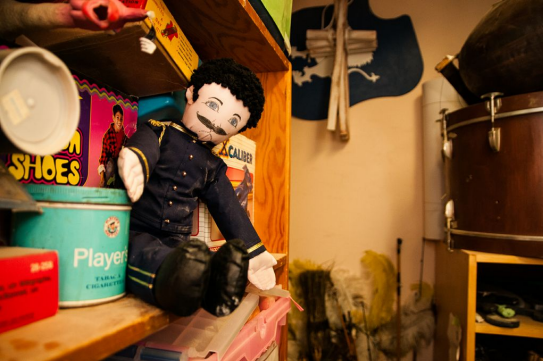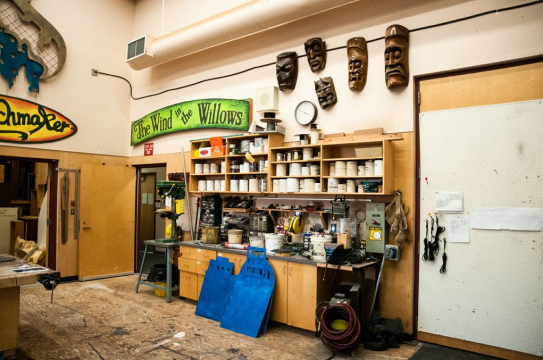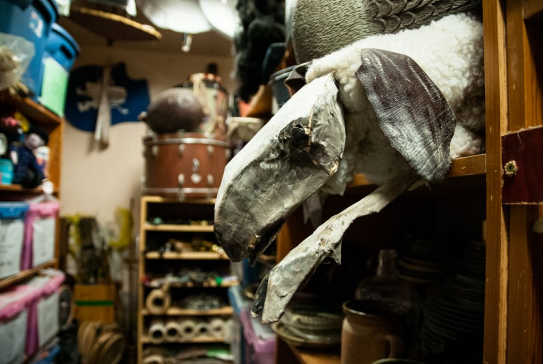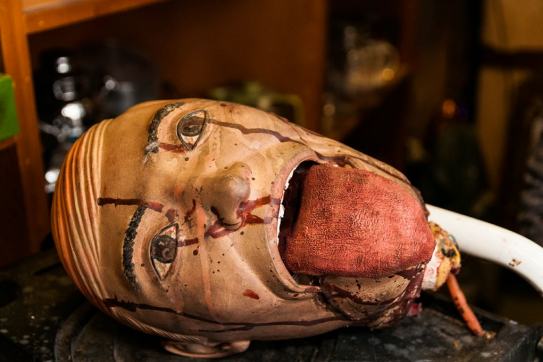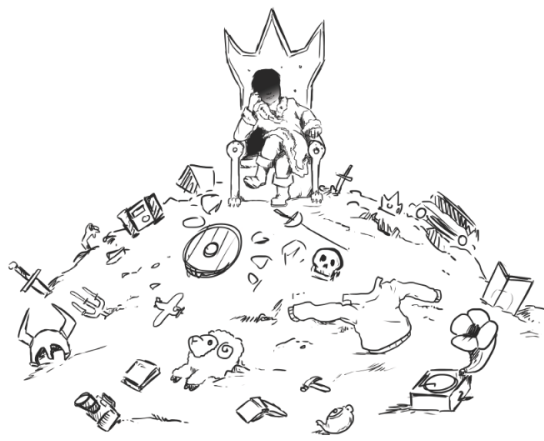By Nick Ubels (The Cascade) – Email
Photos by Blake McGuire (The Cascade) – Email
Print Edition: February 20, 2013
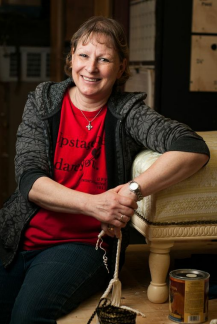 “Just watch where you’re walking that you don’t trip on anything.”
“Just watch where you’re walking that you don’t trip on anything.”
This, and only this, is my brief safety primer from Astrid Beugeling before we depart on an accelerated hour-long tour of UFV theatre’s massive props collection. She estimates that there’s nearly 10,000 items in the collection.
“Think of someone’s worst attic nightmare,” she jokes.
Beugeling is the theatre’s technical manager, and she’s been on staff since 1986. Every item, every nook and cranny of the theatre has a story. Beugeling is one of the few that knows the story behind each of these objects. It is her job to deal in things: props, sets, costumes, you name it. Beugeling is the one responsible for the huge stock of physical properties belonging to the UFV theatre department.
She’s talking excitedly and I’m scrambling to make note of each intricate object I see while praying that my battered Sony voice recorder doesn’t cut out along the way.
I was here on a mission. As soon as I had heard that there might be a real, human skull in UFV’s prop storehouse, I went full Indiana Jones mode about it. I just had to find that skull.
Grim, yes. But endlessly fascinating. Skulls have a long history as a theatre prop, stretching back to Hamlet’s famous grave digger scene in which our despondent Danish prince holds aloft the skull of Yorick, whom he calls “a man of infinite jest.” In a very real, physical way, holding Yorick’s skull prompts a meditation on mortality, connects Hamlet to death and memory of life in a closer, more intimate way.
The 2008 Royal Shakespeare Company production of the play featuring David Tennant attracted plenty of attention for Tennant’s use of a real human skull, one donated to the theatre by Polish pianist Andre Tchaikovsky for such use upon his death. The skull controversy overshadowed Tennant’s reportedly brilliant turn. The question, though, is one of necessity.
Plays and films involve a certain suspension of disbelief. Everything is presented as on a stage, but it’s meant to be convincing. Does something need authenticity to be convincing? Would the audience even notice the difference unless it’s pointed out to them? Do authentic objects allow the actor to perform with more genuine feeling and acuity? Do you need to touch death to become Hamlet?
I put these thoughts to the back of my mind and begin to take in the years of artifacts gathered throughout the space. Unlike a museum, these objects are not held behind glass just to look at, but to be used and adapted as necessary.
Beugeling tells me that just being around so many interesting objects can inspire creative reuse for new productions.
“This looks like an old microphone,” she says, pointing to a facsimile of an old-timey suspended studio mic used in last fall’s production of Once In A Lifetime. “But all it is is a bunch of springs, plastic tubing, and you know, you just create whatever you want.”
We approach a set of three blue and yellow-painted high school lockers marked with masking tape. They’re labelled ROMAN SWORDS, FENCING SWORDS and GUNS.
“Everything’s been welded so you can’t accidentally shoot somebody,” she points out.
“Do you want to look at them?”
I attempt a casual reply, but end up sounding a little too eager, revealing my inner 13-year-old self.
“Yes. Definitely!”
She hands me one of the Roman swords. I hold it at a 45 degree angle with both hands, feeling the surprising weight in the muscles up my arm as I carefully manoeuvre the shaped piece of metal. Beugeling explains that actors go through an intensive training process with one of Canada’s national fight directors before using the real swords.
Fight safety and sword maintenance go hand in hand. Because the swords aren’t forged steel, they get nicks and chips with use, so the backstage crew is responsible for filing down the swords after each night’s performance.
“You have to build these things, but you also have to take care of them,” Beugeling says.
It’s one thing to amass such a collection of odds and ends, but it’s another thing altogether to keep them in working shape. The upkeep required for such a massive collection wasn’t something that had crossed my mind before I entered the belly of the beast of the theatre department – a rag and bone shop. She continues our tour with a quick sweep of the theatre shop. In some of the adjacent rooms are wooden chairs, benches and stools of various styles; rolls of table cloths and green shag carpet; frilly doilies; fake mounted animal heads. There’s a three-tiered metal storage system recycled from old productions of Pentecost and Richard III. Below the scaffolding is a grand piano donated by the Lion’s Club of Chilliwack. The card stock from old show posters are in the process of being converted into things as diverse as fake phonographs and backdrops for UFV’s upcoming production of The Merchant of Venice.
“What I’m working on is called a ground row,” she says. “I’ve got this thing at the back along the floor that creates a skyline. I’m going to create the Rialto bridge with a gondola.”
Beugeling drafts these three-dimensional designs on a program called Sketch Up and cuts the pieces herself, or gets help from resident carpenter Bryan Cutler, who’s busy operating a table saw when I arrive. Massive paintings of frogs and bourgeois maidens, not to mention masks and banners, cover the high-ceilinged walls of the carpentry shop. A small collection of chandeliers is stashed away in the corner.
Some time before Cutler was hired, a local carpenter who did much of the work for the theatre donated a series of five massive Mexican masks. The quartet is carved out of dark-stained wood and hang together above the dock doors used to access the 206-seat theatre.
“Someone gave them to him and told him they’re not supposed to be separated,” she says. The masks have yet to be used in a production, but they’ve lived on the shop wall for nearly 25 years.
Introduction to stage craft
We leave the masks and enter the main campus theatre. In past shows, forklifts, golf carts and other vehicles have all been brought in through the wide dock doors.
“This is a good time for you to come because you can see that we’re in the middle of building a set,” she says as we step into the theatre. There’s bits and pieces of the previous sets all around: an art deco backdrop built for the Once in A Lifetime set, indistinguishable pieces of unpainted wood, a stack of background pieces that will make up the Venice horizon line. There’s a sort of painted watercolour effect that gives the impression of dusk or twilight. Once everything’s been assembled, there will also be little lights twinkling behind the false windows.
Beugeling proudly showcases the T-shaped theatre pit running under the stage. It has removable sections that can house a hand-crank elevator or high jump mats for quick exits. During UFV’s production of The Wind in the Willows in November 1999, they set up a canvas river along the pit. An otter jumped out through a trapdoor under the river and then back in. Between scenes, the backstage crew rolled up the canvas river and closed the trap door.
“It was a really magical moment for people,” Beugeling says as she reminisces about the show.
Beugeling guides me through the lobby and then the production booth. It’s equipped with an infrared light and video system that enables the production manager to make sure everyone’s in position before calling a scene. Everyone’s on headsets so no one is caught off guard.
Next we visit the gallery level and the lighting catwalks. I hold tight to the metal railings. Indiana Jones mode. I look down to see a bird’s eye view of the stage below and have to catch my breath for a second. Beugeling likes to fire up a couple of the “house hang” lights while she paints the sets in order to see how the lighting will change their appearance. In previous shows, they’ve used this level to rig up flying entrances for Humpty Dumpty and The Tempest’s Ariel with the help of military professionals.
“Because if you’re flying people in, you have to be really careful,” Beugeling adds.
We finally descend. My heart rate lowers considerably.
Living in a ghost town
Beugeling takes me out into the main part of the building, towards the prop rooms. It’s like a ghost town. There are abandoned TVs and chairs. I notice a spot where an old pay phone has been hastily pulled from the wall, telephone line still sticking out. There are classrooms that look ready to host a class covered in a thin layer of dust. Every other program that used to share the space with the theatre department has moved to UFV’s new CEP campus in southern Chilliwack. That the empty upper hallway is eerie is something Beugeling and I both pick up on as we start to lower our voices into a whisper.
Beugeling points into a fully-stocked classroom. Door locked, outside blinds drawn. “See, everything’s just left here. It’s so weird,” she says. “Everything’s here but the people are all gone. It’s like a sci-fi movie.”
Before the theatre department moved into the Chilliwack North building in 1994, it worked out of a renovated motel. It was supposed to be a temporary fix, but UCFV theatre was there for nearly 15 years. The university took down a wall and combined two classroom spaces, and that served as the theatre. At that time, when Beugeling was first hired, the entire prop room consisted of one walk-in closet. Over the years, she’s slowly built up the collection through donations, purchases, and getting in touch with local newspapers and businesses.
“I would go into the local newspapers and I’d say, ‘Hey look, if you’re having a garage sale and you have stuff left over, we’ll take it.’” she says.
Every item is now labelled and catalogued in a central inventory. The collection of little treasures and knick-knacks has now expanded to take up four classrooms, a workshop, and two small side rooms. Beugeling unlocks the door to the first classroom and turns to face me before dramatically opening the door.
“What you see right now is the culmination of 30 years of theatre.”
Beugeling flicks on the lights and reveals aisle after aisle of salvaged paraphernalia. There’s ancient bathroom vanities, mannequins, hollowed out book spines, a 1940s radio, barbed wire and dozens of travel trunks.
“I don’t want any more donations of trunks,” Beugeling says, laughing. “I’m done with that.”
While Beugeling doesn’t keep everything used in a UFV production, anything unique or particularly reusable is kept. The rows of stacked goods of every variety is staggering. The imagination runs wild with possibilities. I can see what she means about just being around this stuff inspiring the creative process.
I’m struck by the fact that these items, for the most part, weren’t created as props, but found a second life in the theatre. They all have at least two stories: a life out in the wide world before they were adopted by Beugeling, and a life in the theatre. You can divide those theatre lives by as many times as a prop is used, reused or refashioned into something entirely different.
I wonder about this supposedly real skull’s human life.
It’s a substantial collection that not every theatre department can offer. Beugeling, a UVic theatre tech graduate, says that UFV’s collection now rivals that of the bigger schools like UBC and UVic. High schools, church groups, private theatre troupes and other universities from throughout the Fraser Valley and beyond often borrow gear from UFV for their productions.
Beugeling shows me through the three or four costume rooms. There are racks of military uniforms, bins upon bins of shirts, fur coats, capes, an entire room of boots and a couple of creepy mascots heads donated by a former costume rental guy. In the sewing room, there are extra hangers and other bits and pieces hanging from piping on the ceiling.
“As you can see, we try to utilize every little space we have,” Beugeling says.
Limbs, eyes and bones
We finally arrive back in the hand prop room just off of the main shop. On one of the back shelves, Beugeling spots a bag of heads made for Richard III.
“Richard kills. He kills a bunch. He kills everybody,” Beugeling adds with a slight grin.
Each of the heads was cast from an alginate mold placed on each actor’s face with a straw to let them breathe. The plaster of paris cast would then be filled out with papier mache and affixed to a smaller wig head. She used bits of wigs to approximate the hairstyles and eyebrows and gummy fishing lures and wires to stand in for protruding blood vessels and veins, imitating the look of a freshly severed head.
For one actor, Beugeling had to cast the head with his mouth open at the director’s request.
“In the scene, Richard pulls this strawberry out of this head that’s served to him on a platter,” Beugeling says. “He pulls it out and eats it.”
The parade of body parts continues as Beugeling rifles through a box of stray limbs and other pieces donated by the health sciences department when they no longer needed them.
“Because you never know when you’ll need a torso,” she tells me.
And then we find it. The skull.
It’s browned with age and it looks like it’s about to fall apart. It had been buried in the bottom of a plastic bin filled with skulls, bones and other body parts. Before I know it, Beugeling has handed me the skull as she continues to browse through the plastic bin. I stare at the horrifically empty face and wonder. Rather than being moved to a monologue, I’m dumbstruck. This is someone’s skull, someone who died at least 30 years ago. After a few minutes of silence, I pass the aging skull back to Beugeling and ask her where it came from.
She tells me that it was already there when she was first hired over 25 years ago. Theatre legend has it the skull simply arrived in a cardboard box one day.
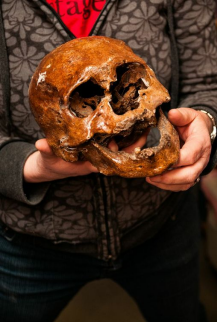 While the UFV theatre has performed Hamlet twice during Beugeling’s era, she doesn’t think the real skull’s ever been used other than as set decoration. It’s just too fragile to be handled constantly. In this case, it seems that durability beats authenticity. Beugeling packs the skull back into its box, alongside fake thigh bones and a bag of googly eyes.
While the UFV theatre has performed Hamlet twice during Beugeling’s era, she doesn’t think the real skull’s ever been used other than as set decoration. It’s just too fragile to be handled constantly. In this case, it seems that durability beats authenticity. Beugeling packs the skull back into its box, alongside fake thigh bones and a bag of googly eyes.
“In the theatre world, you come across all sorts of strange things,” Beugeling says, noticing me staring at the box. “And that’s what we all love about it. It’s so weird and strange.
“Even though you’re doing the same kind of job, you’re always reinventing or finding a way to make something new.”
When Beugeling first joined UFV’s theatre department, there was scarcely a closet full of props. Now there are endless rooms and corners of the building filled with different objects she’s assembled over the years. I realize that what I’m looking at is more than a series of fascinating props, but a quantifiable, visual representation of one woman’s life’s work.
“That’s one of the things when I leave,” she says, pausing. “I know everything they’ve used since 1986. I have a fairly good memory of everything we have and where it is. That’s not something you can just tell somebody.”
Beugeling turns to show me the door to her office, covered with photographs of her former students. Some have gone on work in the lighting crew of internationally touring rock bands, others have joined production studios or theatre companies. Many have become teachers, who regularly visit to borrow props for their plays. One of her students is currently sitting as a Chilliwack city councillor.
She tells me that the masks are her favourite props to make. Opening the door of her office, she retrieves a red, blue and white minstrel mask, complete with hat and bells, from her coat hanger. The mask was made by one of her former students, Jay Havens. It is perfectly carved and coated with spackling paste and carefully painted.
“It’s all about taking your time,” she says, admiring the mask. “You can put spackle on top and smooth it out because papier mache can be rough. But by taking your time and having a good vision, you can make it into something beautiful.”


